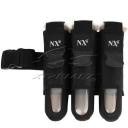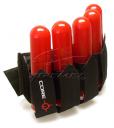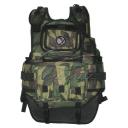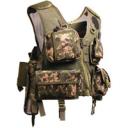There are no products listed under this category.
The simplest form is the basic paintball belt pouch. These are attached to a belt and usually hold two or three pods. They have a velcro affixed flap that holds the pod in place and often have an elastic ejector to help ease the pod into your hand. The advantages are pretty simple. They are lightweight, unobtrusive and affordable for any budget. The downside is the limited capacity and the tendency to flop around noisily.
 Gen X 2 Pod Pouch
Gen X 2 Pod Pouch NXe 3 Pod Pouch
NXe 3 Pod Pouch
A very common harness is the horizontal harness. These strap around your waist carry pods horizontally on your lower back. These often include a large pouch to carry a tank for use with a coiled remote hose. If the harness has this pouch it is designated as â+1â³, so if a harness is referred to as a â4+1 Horizontalâ that means it carries four pods horizontally plus a tank. These harnesses are generally secured around the waist by a strap with a buckle or velcro. Harnesses can get very heavy when loaded with full pods and a tank so many have attachments points for suspenders or come with suspenders as part of the harness.
Horizontal harnesses have a few advantages. Pods are easier to reach than in a vertical harness for most people and are easier to slide back in. During âspeedballâ games on concept fields players typically drop pods and pick them up afterwards but this is not practical in woods and big games so the ability to quickly and easily put empties back into your harness is a big plus. Horizontals also tend to fit the larger, plus sized players more comfortably. The downside to a horizontal is that because they are so wide they tend to stick out on the sides, making you a bigger target, and forget about trying to roll when on the ground. Most horizontal packs carry half the pods to the left and half to the right, which means youâll need to switch hands or reload with your awkward offhand half the time.
This leads us to vertical harnesses. These are harnesses that carry the pods straight up and down across the small of your back. Vertical harnesses evolved with the rise of tournament-style âspeedballâ games to fill the demand for as low a profile as possible and to access all pods with either hand.
Designs vary but the one feature virtually all vertical packs have now is the elastic waistbelt that stretches around your waist like a back support belt, fastening with velcro in the front. This keeps the pack snug to your body and also can give some support to your back. Pods are worn pointing down for quick and low profile removal. Most have formed slots for your pods with a velcro strap to keep them in place. Others like the Empire Hinge Pack have flexible slots without retaining straps, instead utilizing a strong elastic band creating tension to hold the pods in place. As pods are pulled away the harness collapses on itself, thus reducing its target profile with each reload.
 CORE 5 Pod Slam
CORE 5 Pod Slam  NXe Alex Fraige Edition
NXe Alex Fraige Edition  Empire Hinge Pack
Empire Hinge Pack
Often a harness has extra loops of elastic that is sewn between slots. These unfold past the slot and can fit a pod snugly. If a harness just has x number of slots for pods⦠lets say three for example⦠then it is simply referred to as a 3 Pod Harness. If it has the extra loops⦠for example two⦠then it is called a 3+2 Pod Harness
The plus side to vertical harnesses is that they offer minimal profile and ambidextrous access. The downside is that empty pods are slow if not very difficult to slide back into place midgame. Dropping the pod and collecting them later is fine on speedball fields but not so much in the woods where pods are sure to be lost or picked up by others.
The last category is the tactical vest or âtac vestâ for short. These are incredibly popular in scenario/ big games or for outlaw rec games where you might not be heading back to the staging area for long periods of time. Copied from equipment worn by police and military, theyâre typically a full vest or belt/ shoulder harness combo with a variety of pouches, pockets, clips and other anchor points to comfortably distribute weight when carrying lots of gear.
 Gen X Tactical
Gen X Tactical  Spec Ops Broadsword
Spec Ops Broadsword  NXe Light Infantry Vest
NXe Light Infantry Vest
Some vests have pouches sewn permanently in place. While you canât rearrange the layout these hold your gear most securely. Others have large sections of velcro backing so pouches can be arranged and oriented as the user desires. More and more vests are utilizing the militaryâs MOLLE system. Short for âMOdular Lightweight Load-carrying Equipmentâ, these are rows of webbing sewn in increments to form a base for MOLLE-compatible accessories to be secured to. These accessories have straps that thread through the MOLLE webbing and snap into place, offering more versatility since many army surplus and other specialty pouches can be used as well.
Common pouches for paintball tac vests include GP (General Purpose) pouches, pull-down pouches so you can show refs your ID/ Mission card, elastic loops for 12 grams and ten round tubes, ones to hold a tank vertically or horizontally and large sturdy areas to hold a hydration system bladder. When choosing or setting up a vest, make a list of everything you have ever used on the field and then visualize where it will go. The most used items like pods and squeegees should go in the more easily accessible locations⦠your energy bars, rags, spare o-rings and cel phone can go into the smaller pouches off to the side. Leave your shooting shoulder clear for the markerâs tank or stock to sit and remember to test it with your paintball marker going from a carrying to firing position. Any pouch that interferes with this motion is going to drive you nuts by the end of a long game day!
That should help you pick out what kind of harness you should get. Just consider your playing style and the type of games you plan on playing. Here are some more tips:
â Make sure you snap the lids of your pods securely. Nothing is more frustrating or embarassing than pulling down a strap for a pod and having paint dump down your leg.
â Orient the thumbtab of the podâs lid when you load up your harness so that the tab sits where your thumb is when you grab the pod. This saves you valuable time when reloading under stress.
â Some harnesses feature ejector loops of elastic material that help push the pod out a bit, making them easier to grab. These speed up reloading.
There are no products listed under this category.